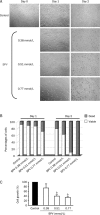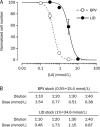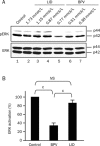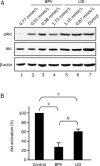Bupivacaine causes cytotoxicity in mouse C2C12 myoblast cells: involvement of ERK and Akt signaling pathways
- PMID: 20228829
- PMCID: PMC4007657
- DOI: 10.1038/aps.2010.20
Bupivacaine causes cytotoxicity in mouse C2C12 myoblast cells: involvement of ERK and Akt signaling pathways
Abstract
Aim: The adverse effects of local anesthetics (LAs) on wound healing at surgical sites have been suggested, and may be related to their cytotoxicity. This study was aimed to compare the cellular toxicity of bupivacaine and lidocaine (two well-known LAs), and to explore the molecular mechanism(s).
Methods: Toxicity of bupivacaine and lidocaine was assessed in cultured mouse C2C12 myoblasts by cell viability and apoptosis assays. Effects of LAs on extracellular signal-regulated kinase (ERK) and protein kinase B (Akt) activation, which are essential for cell proliferation and survival, were evaluated by immunoblotting.
Results: Both LAs, especially bupivacaine, prevented cell growth and caused cell death in a dose-dependent manner. The half maximal inhibitory concentrations (IC(50)) for bupivacaine and lidocaine were 0.49+/-0.04 and 3.37+/-0.53 mmol/L, respectively. When applied at the same dilutions of commercially available preparations, the apoptotic effect induced by bupivacaine was more severe than that of lidocaine in C2C12 cells. Furthermore, bupivacaine significantly diminished the ERK activation, which may underlie its anti-proliferative actions. Both LAs suppressed Akt activation, which correlated with their effects on apoptosis.
Conclusion: Our study demonstrated that, when used at the same dilutions from clinically relevant concentrations, bupivacaine is more cytotoxic than lidocaine in vitro. Anti-proliferation and cell death with concomitant apoptosis mediated by bupivacaine may offer an explanation for its adverse effects in vivo (eg slowing wound healing at the surgical sites). A less toxic, long-acting anesthetic may be needed.
Figures





Similar articles
-
Cytotoxicity of local anesthetics in human neuronal cells.Anesth Analg. 2009 Mar;108(3):997-1007. doi: 10.1213/ane.0b013e31819385e1. Anesth Analg. 2009. PMID: 19224816
-
Cytotoxic effects of ropivacaine, bupivacaine, and lidocaine on rotator cuff tenofibroblasts.Am J Sports Med. 2014 Dec;42(12):2888-96. doi: 10.1177/0363546514550991. Epub 2014 Oct 8. Am J Sports Med. 2014. PMID: 25296645
-
Lithium attenuates bupivacaine-induced neurotoxicity in vitro through phosphatidylinositol-3-kinase/threonine-serine protein kinase B- and extracellular signal-regulated kinase-dependent mechanisms.Neuroscience. 2012 Mar 29;206:190-200. doi: 10.1016/j.neuroscience.2011.12.043. Epub 2012 Jan 3. Neuroscience. 2012. PMID: 22233781
-
Comparison of toxicity effects of ropivacaine, bupivacaine, and lidocaine on rabbit intervertebral disc cells in vitro.Spine J. 2014 Mar 1;14(3):483-90. doi: 10.1016/j.spinee.2013.06.041. Epub 2013 Aug 23. Spine J. 2014. PMID: 23978626
-
Potential neurotoxicity of spinal anesthesia with lidocaine.Mayo Clin Proc. 2000 Sep;75(9):921-32. doi: 10.4065/75.9.921. Mayo Clin Proc. 2000. PMID: 10994828 Review.
Cited by
-
Kilohertz high-frequency alternating current blocks nerve conduction without causing nerve damage in rats.Ann Transl Med. 2019 Nov;7(22):661. doi: 10.21037/atm.2019.10.36. Ann Transl Med. 2019. PMID: 31930062 Free PMC article.
-
Lidocaine Inhibits Myoblast Cell Migration and Myogenic Differentiation Through Activation of the Notch Pathway.Drug Des Devel Ther. 2021 Mar 2;15:927-936. doi: 10.2147/DDDT.S290002. eCollection 2021. Drug Des Devel Ther. 2021. PMID: 33688167 Free PMC article.
-
Local toxicity from local anesthetic polymeric microparticles.Anesth Analg. 2013 Apr;116(4):794-803. doi: 10.1213/ANE.0b013e31828174a7. Epub 2013 Mar 4. Anesth Analg. 2013. PMID: 23460564 Free PMC article.
-
Hyaluronan suppresses lidocaine-induced apoptosis of human chondrocytes in vitro by inhibiting the p53-dependent mitochondrial apoptotic pathway.Acta Pharmacol Sin. 2016 May;37(5):664-73. doi: 10.1038/aps.2015.151. Epub 2016 Apr 4. Acta Pharmacol Sin. 2016. PMID: 27041463 Free PMC article.
-
Maternal sciatic nerve administered bupivacaine induces hippocampal cell apoptosis in offspring.BMC Anesthesiol. 2020 Sep 7;20(1):228. doi: 10.1186/s12871-020-01143-2. BMC Anesthesiol. 2020. PMID: 32894054 Free PMC article.
References
-
- Malhotra N, Chanana C, Roy KK, Kumar S, Riwari V, Sharma JB. To compare the efficacy of two doses of intraperitoneal bupivacaine for pain relief after operative laparoscopy in gynecology. Arch Gynecol Obstet. 2007;276:323–6. - PubMed
-
- Fong SY, Pavy TJ, Yeo ST, Paech MJ, Gurrin LC. Assessment of wound infiltration with bupivacaine in women undergoing day-case gynecological laparoscopy. Reg Anesth Pain Med. 2001;26:131–6. - PubMed
-
- Einarsson JI, Sun J, Orav J, Young AE. Local analgesia in laparoscopy: a randomized trial. Obstet Gynecol. 2004;104:1335–9. - PubMed
-
- Foster AH, Carlson BM. Myotoxicity of local anesthetics and regeneration of the damaged muscle fibers. Anesth Analg. 1980;59:727–36. - PubMed
Publication types
MeSH terms
Substances
Grants and funding
LinkOut - more resources
Full Text Sources
Miscellaneous

